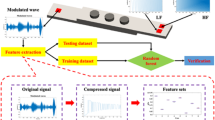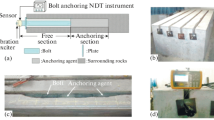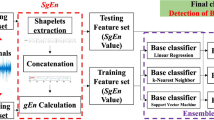Abstract
Bolt connections are widely used in aero-engine rotors and gas turbines because of their load-transferring and detachable characteristics. However, bolts are prone to looseness due to the influence of fatigue, shock, and thermal loads, which decreases the reliability of the bolted connection structure. Therefore, detecting the assembly tightness of bolted connections is critical to ensure structural integrity during the assembly phase. A high-order cumulant-gray-level image feature (HOC-GLI) method is proposed to detect the assembly tightness of bolt connections. The core of this new method is to obtain high-order cumulant images of vibration signals to eliminate noise and reserve rich nonlinear information. The amplitude distribution of the third-order cumulant reflects the energy distribution of the vibration signal in 3D images. Then, the third-order cumulant 3D images are converted to 2D gray-level images to extract the texture feature. Finally, the root entropy index of the normalized gray-level cooccurrence matrix (GLCM) based on gray-level images is used to indicate the complexity of image information. Experimental studies on six bolt connection states of the aero-engine rotor are conducted. The relationship between the root entropy index and bolted connection status is obtained to verify the effectiveness of the proposed method for assembly tightness detection in different bolt connection statuses. The result shows that the root entropy index has a decreasing trend with the loosening of the bolts, which can quantitatively detect the assembly tightness of the bolt connection structure.
Similar content being viewed by others
References
J. C. Zhang, X. N. Yang and J. Wang, On-line air-tightness and insertion loss simultaneous detection method of high air-tightness fiber optic penetration connector, 2015 International Conference on Optical Instruments and Technology: Optical Sensors and Applications, Beijing, China (2015).
S. M. Y. Nikravesh and M. Goudarzi, A review paper on looseness detection methods in bolted structures, Latin American Journal of Solids and Structures, 14 (12) (2017) 2153–2176.
F. R. Wang, S. C. M. Ho and G. B. Song, Modeling and analysis of an impact-acoustic method for bolt looseness identification, Mechanical Systems and Signal Processing, 133 (2019) 106249.
F. R. Wang and G. B. Song, Bolt-looseness detection by a new percussion-based method using multifractal analysis and gradient boosting decision tree, Structural Health Monitoring-an International Journal, 19 (6) (2020) 2023–2032.
Q. K. Li and X. J. Jing, Fault diagnosis of bolt loosening in structures with a novel second-order output spectrum-based method, Structural Health Monitoring-An International Journal, 19 (1) (2020) 123–141.
P. Razi, R. A. Esmaeel and F. Taheri, Improvement of a vibration-based damage detection approach for health monitoring of bolted flange joints in pipelines, Structural Health Monitoring-An International Journal, 12 (3) (2013) 207–224.
F. R. Wang and G. B. Song, A novel percussion-based method for multibolt looseness detection using one-dimensional memory augmented convolutional long short-term memory networks, Mechanical Systems and Signal Processing, 161 (2021) 107955.
S. C. Cao, N. Guo and C. Xu, Robust damage localization in plate-type structures by using an enhanced robust principal component analysis and data fusion technique, Mechanical Systems and Signal Processing, 162 (2022) 108091.
Q. K. Li and X. J. Jing, A novel second-order output spectrum based local tuning method for locating bolt-loosening faults, Mechanical Systems and Signal Processing, 147 (2021) 107104.
L. T. Wang, B. Yuan and Z. B. Xu, Synchronous detection of bolts looseness position and degree based on fusing electromechanical impedance, Mechanical Systems and Signal Processing, 174 (2022) 109068.
I. M. Lee, S. I. Han and H. J. Kim, Evaluation of rock bolt integrity using Fourier and wavelet transforms, Tunnelling and Underground Space Technology, 28 (2012) 304–314.
X. S. Qin, C. Peng and G. Z. Zhao, Full life-cycle monitoring and earlier warning for bolt joint loosening using modified vibro-acoustic modulation, Mechanical Systems and Signal Processing, 162 (2022) 108054.
N. Kaur, L. F. Li and S. Bhalla, A low-cost version of electromechanical impedance technique for damage detection in reinforced concrete structures using multiple piezo configurations, Advances in Structural Engineering, 20 (8) (2017) 1247–1254.
D. M. Peairs, G. Park and D. J. Inman, Improving accessibility of the impedance-based structural health monitoring method, Journal of Intelligent Material Systems and Structures, 15 (2) (2004) 129–139.
N. K. Mishra, P. K. Dash and N. Yashwanth, Damage monitoring of single lap bonded composite using acoustic emission technique, IOP Conference Series: Materials Science and Engineering, 455 (2018) 012026.
K. Jian, N. Wang and Q. Li, Research on acoustic emission identification test method of single-tube tower model and base plate bolted connection, Journal of Southwest University of Science and Technology, 28 (3) (2013) 45–49.
J. W. Lee, Bolt-joint structural health monitoring technique using transfer impedance, Journal of Korea Academia-Industrial Cooperation Society, 20 (7) (2019) 387–392.
S. Wei and Z. Ying, Numerical simulation of bolt looseness monitoring based on impedance method, Applied Mechanics and Materials, 351–352 (2013) 1264–1268.
A. Soualhi, K. Medjaher and N. Zerhouni, Bearing health monitoring based on hilbert-huang transform, support vector machine, and regression, IEEE Transactions on Instrumentation and Measurement, 64 (1) (2015) 52–62.
W. Zhou, L. Xiao and W. Qu, Detection of bolt looseness in frame structures using empirical mode decomposition, Journal of Vibration and Shock, 35 (8) (2016) 201–206.
X. L. Zhang, Q. Yan and J. Yang, An assembly tightness detection method for bolt-jointed rotor with wavelet energy entropy, Measurement, 136 (2019) 212–224.
S. K. Goumas, M. E. Zervakis and G. S. Stavrakakis, Classification of washing machines vibration signals using discrete wavelet analysis for feature extraction, IEEE Transactions on Instrumentation and Measurement, 51 (3) (2002) 497–508.
D. F. Shi, W. J. Wang and L. S. Qu, Defect detection for bearings using envelope spectra of wavelet transform, Journal of Vibration and Acoustics, 126 (4) (2004) 567–573.
E. C. C. Lau and H. W. Ngan, Detection of motor bearing outer raceway defect by wavelet packet transformed motor current signature analysis, IEEE Transactions on Instrumentation and Measurement, 59 (10) (2010) 2683–2690.
L. Fucai, M. Guang and Y. Lin, Wavelet transform-based higher-order statistics for fault diagnosis in rolling element bearings, Journal of Vibration and Control, 14 (11) (2008) 1691–1709.
E. Orosco, P. Diez and E. Laciar, On the use of high-order cumulant and bispectrum for muscular-activity detection, Biomedical Signal Processing and Control, 18 (2015) 325–333.
Y. J. Shen, S. Yang and J. Wang, Application of higher-order cumulant in fault diagnosis of rolling bearing, Journal of Physics: Conference Series, 448 (2013) 012008.
W. Mu, L. Shi and Y. Cai, Diesel engine fault diagnosis based on the global and local features fusion of time-frequency image, Journal of Vibration and Shock, 37 (10) (2018).
S. Zhang, Y. Cai and L. Shi, Coding feature extraction and diagnosis of i.c. engine vibration time-frequency images, Mechanical Science and Technology for Aerospace Engineering, 37 (3) (2018) 391–395.
X. X. Ding, Q. B. He and Y. M. Shao, Transient feature extraction based on time-frequency manifold image synthesis for machinery fault diagnosis, IEEE Transactions on Instrumentation and Measurement, 68 (11) (2019) 4242–4252.
W. Dou, Z.-S. Liu and Z.-X. Wang, Vibration fault diagnosis method based on gray level-gradient co-occurrence matrix for rotating machinery, Journal of Aerospace Power, 23 (10) (2008) 1939–1943 (in China).
H. Shen, H. Zhao and J. Mei, Diesel engine fault diagnosis based on high-order cumulant image features, Journal of Vibration and Shock, 34 (11) (2015) 133–138.
H. Rujiang, O. An, L. U. Wenxiu and C. H. U. Fulei, Review of diagnosis of rolling element bearings defaults by means of acoustic emission technique, Journal of Vibration and Shock, 27 (3) (2008) 75–79.
Acknowledgments
This research is supported by Shaanxi Provincial Natural Science Basic Research Program (Grant No. 2021JM-169), joint funding from the Equipment Pre-research Department of the Ministry of Education of the People’s Republic of China (Grant No. 6141A02033111) and Youth Talent Promotion Project Shaanxi Association of Science and Technology (Grant No.20170509).
Author information
Authors and Affiliations
Corresponding author
Additional information
XiaoLi Zhang received a Ph.D. degree in mechanical engineering from Xi’an Jiaotong University, Xi’an, China in 2011. Currently, she is an Associate Professor in the Department of Mechanical and Electronic Engineering, School of Construction Machinery, Chang’an University, Xi’an, China. Her research interests include signal processing, deep learning, machinery condition monitoring, and intelligent fault diagnosis.
Yong Xia received a master’s degree in mechanical engineering from the Chang’an University of Xi’an, China in 2022. He is currently an algorithm engineer with TCL Tongli Electronics Co., Ltd., China. His research interests include speech recognition, signal processing, deep learning, and fault diagnosis.
Qiang Yan received a master’s degree in mechanical engineering from the Chang’an University of Xi’an, China in 2019. He is currently a vocational college teacher in Sanmenxia Social Management Vocational College. His research interests include fault diagnosis and signal processing.
Xiao Yong received a bachelor’s degree from Hunan University of Arts and Science, ChangDe, China in 2017. He is currently pursuing a master’s degree with the School of Engineering Machinery, Chang’an University, Xi’an, China. His current research interests include fault diagnosis and signal processing.
Rights and permissions
About this article
Cite this article
Xia, Y., Zhang, X., Yan, Q. et al. Assembly tightness detection of bolt connections using gray-level images with high-order cumulants. J Mech Sci Technol 37, 4981–4988 (2023). https://doi.org/10.1007/s12206-023-0905-8
Received:
Revised:
Accepted:
Published:
Issue Date:
DOI: https://doi.org/10.1007/s12206-023-0905-8




